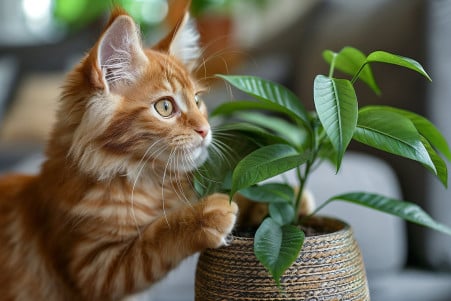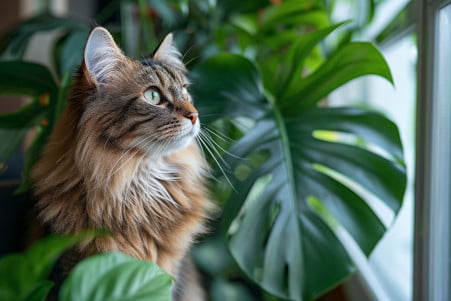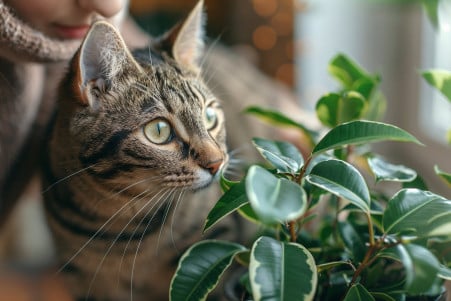How to Keep Cats Away From Plants: Tips for Your Indoor Garden
1 May 2024 • Updated 30 April 2024

It can be tough to keep your indoor plants safe from your cat, but there are many ways to keep your cat from destroying your greenery. You can use scents that cats don’t like, such as citrus, cayenne pepper, or coffee grounds on the soil. You can also use rough materials like pine cones or aluminum foil to cover the soil. To keep plants out of reach, you can put them on high shelves or in hanging baskets. You can also use deterrent sprays, double-sided tape, or citrus peels to create a barrier around your plants.
In the past few years, researchers have investigated a number of natural, ethical methods to keep cats from destroying your indoor garden. In this article, we'll explore the findings of these studies, which have been conducted by horticultural researchers, veterinary behaviorists, and cat parents, to find out what really works when it comes to keeping cats from treating your potted plants like their personal scratching posts and salad bars. By following the evidence-based advice from these studies, you can ensure that your indoor garden stays healthy and vibrant while also making sure your cat stays happy and well.
How can I keep cats away from plants?
How to Find Safe and Poisonous Plants for Cats
There are many plants that are poisonous to cats, including common houseplants like lilies, snake plants, and monsteras. Cats' metabolisms can make them more sensitive to certain plant chemicals that other animals can easily tolerate. Symptoms of plant toxicity in cats can include drooling, vomiting, lethargy, neurological symptoms such as walking like they are "drunk," and in the most severe cases, organ failure. If you think your cat has eaten something toxic, call the ASPCA Animal Poison Control Center right away.
On the other hand, there are also many non-toxic indoor plants that are safe for cats. Some of these include spider plants, African violets, Boston ferns, Venus flytraps, cast iron plants, prayer plants, Chinese money plants, and ponytail palms. When planning a cat-friendly outdoor garden, consider adding catnip, sunflowers, marigolds, petunias, and some herbs that are safe for cats. With a little bit of planning, you can create a safe indoor jungle and outdoor paradise for you and your cat.
Deterrent Methods: How to Keep Cats Away from Plants Without Harming Them
Common household scents such as citrus, vinegar, and cayenne pepper can be used to make plants less appealing to cats, according to How to Keep Cats Away from Plants. In addition, covering the soil with aluminum foil, rocks, or pine cones can help deter cats from digging and scratching in the soil, as cats don’t like the feel of these materials.
Hanging plants or placing them on high shelves can help keep cats away from plants by limiting their access to them. This can make it harder for cats to get to the plants and interact with them. Offering cat-friendly plants such as catnip or cat grass can also help distract cats from other plants that may be toxic to them, according to A Paws-itive Guide to Keeping Your Cat Away from Your Plants.
In addition, motion-activated air spritzers or double-sided tape can be used to keep cats away from plants without hurting them, according to Expert Tips for How to Keep Cats Away from Plants | Trusted Since 1922. By using a combination of these different deterrents, you can help ensure that your cat stays away from your indoor and outdoor plants.
Positive Reinforcement Training for Plant Protection
Positive reinforcement training can help cats learn to avoid certain plants or areas, according to How to STOP Your Cat from Eating Your Plants (Proven Methods). Positive behaviors, such as using specific scratching posts or toys, can be rewarded to help encourage them. The 'leave it' command can be trained with treats and praise when the cat doesn't eat plants, which is also explained in the same article.
Redirecting natural chewing and digging behaviors with safe alternatives, such as cat-friendly plants or chew toys, can help, according to 3 Ways to Prevent Cats from Eating Plants. Meanwhile, How to Keep Cats Out of Plants | Family Handyman emphasizes that training requires patience, consistency, and an understanding of what motivates the cat. By working to address the root cause of the cat's behavior, you can help them form positive associations with the behaviors you want to encourage, which can also help strengthen your relationship with your cat.
How to Make a Cat-Friendly Garden
If you want to go all in on creating a garden that your cat will love, you can design your outdoor space to include climbing structures, hiding spots, and play areas. As noted by Cat-Friendly Plants For Gardens - How To Make Safe Gardens For Cats, cats love to climb, hide, and pounce, so you can add cat posts, fencing, and trees to the space to enrich their environment. You can also plant shrubs close together to create hiding spots that will let your cat stalk and pounce.
In addition to these features, you can encourage your cat to explore the garden by creating play areas and activity zones. Adding soft pathways and toys to the garden will make it more appealing to your cat. The same article suggests planting cat-friendly plants, including catnip, cat grass, sunflowers, and cosmos. If you want to add edible plants to your garden, you can also plant cucurbits, such as cucumbers and beans, which will be safe for your cat and will also give them a place to climb.
To ensure that your cat will be comfortable in the garden, you should also make sure that they have access to shade and water. You should also avoid using any pesticides or fertilizers that could be harmful to your cat. According to Real Homes, you can use organic, pet-safe products like seaweed concentrate. By adding these features to your garden, you can create a paradise for your cat that will also satisfy your green thumb.
Dealing With Underlying Issues and Providing Enrichment
If your cat is chewing or digging in your plants, it may be due to boredom, lack of stimulation, or nutrient deficiencies, according to Keeping Your Cat Out of Your Houseplants | Preventive Vet. These issues can be addressed by providing regular play sessions, interactive toys, and scratching posts to help satisfy your cat’s natural instincts, as suggested by How to STOP Your Cat from Eating Your Plants (Proven Methods) – OutdoorBengal.
Making sure your cat is getting a balanced diet and talking to your vet about any potential nutrient deficiencies can help address any issues that may be contributing to your cat’s plant-chewing behavior. According to Pet Friendly House Indoor Plants For Cats & Dogs | Lively Root, cats are more likely to eat plants if they are missing certain nutrients in their diet.
In addition, regularly rotating toys and enrichment activities can help prevent boredom and keep your cat mentally engaged, which can help reduce the likelihood that they will turn to your plants for stimulation. Finally, a combination of environmental enrichment and positive reinforcement training, which are described in the previous sections, can help you address your cat’s plant-related behaviors in a way that is both kind and successful.
Conclusion: Living in Harmony With Plants and Cats
It is possible to have a thriving indoor garden and a cat-friendly outdoor space while keeping your feline friends safe and happy. A combination of deterrents, positive reinforcement training, and environmental enrichment can help prevent cats from eating plants. Understanding your cat's motivations and providing safe alternatives are key to addressing the root causes of unwanted behaviors.
Creating a balanced, enriching environment for both plants and cats promotes a harmonious coexistence. By following the advice and suggestions of the experts, cat owners can enjoy the benefits of indoor and outdoor plants without compromising the safety of their cats.


